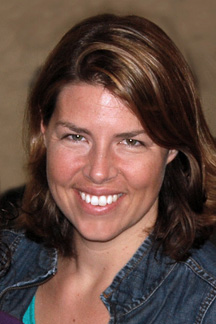Outsmarting Viruses: A Profile of Erica Ollmann Saphire
By Madeline McCurry-Schmidt
In Erica Ollmann Saphire’s field, it’s humans versus viruses—and the viruses have a head start.
“These clever little beasts evolve much, much faster than we do,” said Saphire, a professor at The Scripps Research Institute (TSRI) and alumna of the institute’s graduate program. “They are constantly mutating.”
Viruses may be clever, but Saphire is committed to defeating the worst of them, especially hemorrhagic fever viruses.
Hemorrhagic fever viruses include Ebola virus, Lassa virus and Marburg virus—three infamous pathogens known for spreading quickly and killing up to 90 percent of people infected.
“They’re some of the worst viruses known to man,” said Saphire, “and the particular thing about them, on the molecular level, is that they have very few genes.”
Some viruses have more than 100 genes, but the viruses Saphire studies only have four or seven genes to perform all their functions. These viruses simply do more with less—and Saphire wants to know how.
Seeing Viruses in 3-D
Saphire and her team use a method called X-ray crystallography to build three-dimensional models of hemorrhagic fever viruses to provide critical information for developing new therapies. By using molecular engineering, the team prompts protein molecules from a virus to align and form a crystal. Saphire said it is not unusual to take three to five years to find crystals that diffract the X-rays to high enough resolution that the structure can be determined.
“There are a lot of technical challenges in getting these structures,” said Saphire. “For some of them, we have to express the protein 100 or 500 different ways, so it can be years before we get the thing to grow the crystals. You really have to be relentless.”
The scientists then use X-ray beams at a synchrotron facility. When the beams hit the electrons in the crystal, they create a diffraction pattern that reveals the organization of the crystal and the molecular structure of the protein that formed it.
The scientists then analyze the data to create a computer model of the protein, which researchers use to find sites where the virus is vulnerable to antibodies or drugs.
Working with other scientists who specialize in a range of approaches, Saphire’s latest project focuses on finding the best antibody “cocktail” to fight the Ebola virus. With a five-year grant of up to $28 million from the National Institutes of Health, Saphire leads a new multi-institution center for excellence dedicated to finding the most effective treatment.
Why Viruses?
Saphire didn’t always plan to study the world’s worst viruses. As an undergraduate, she majored in biochemistry and ecology. “Then I took this course in structural biology and it was like the skies parted and the light shone down and angels started singing,” said Saphire.
Saphire loved seeing proteins as three-dimensional structures instead of just bands on a gel, so she decided to pursue structural biology in graduate school. When she read a New York Times article on the first antibody to inactivate most kinds of HIV, she realized the structure of that antibody would be key to understanding how to make a vaccine, and she asked for that antibody as her thesis project.
As a graduate student at TSRI, she thrived in an environment where she could choose her own research focus, laboratory and even thesis committee. “Everything was tailored to advance your research,” Saphire said. “You had your own high-profile project.”
Today, Saphire shares her passion for structural biology and virology with graduate students at TSRI. She encourages her students to consider a virus’s biology, not just its shape.
This perspective came in handy in a 2013 study of the Ebola virus. Though other researchers had solved the structure of a key protein in the Ebola virus, Ebola VP40, many years before, Saphire and her postdoc Zach Bornholdt realized this structure did not explain how the protein performed important functions such as membrane trafficking and virus assembly.
“When we purified it in a different way, we got a different assembly,” said Saphire. “We wondered if this new structure answered functions that we didn’t know before.”
Her lab discovered that the protein folds into several shapes, each new shape performing a different step in the virus’s life cycle. The protein rearranged itself to become different things at different times. This contradicted a long-held assumption in biochemistry.
“What you learn on your mother’s knee, when you’re a biochemist, is that a protein has a certain sequence, and that sequence drives its particular fold, and that fold drives its function—on a one-directional highway,” said Saphire.
Yet this protein twisted itself into new shapes—and, luckily, each shape gives biochemists a new chance to make drugs to interrupt how the protein works.
Saving Lives in Sierra Leone
For Saphire, the ultimate goal is developing treatments that can be used all around the world. In her own travels to West Africa, Saphire has visited communities that desperately need treatments for hemorrhagic fever viruses.
A few months ago, Saphire sat in a village in Sierra Leone, watching the community enjoy Nigerian music videos. She was there to observe local outreach efforts. In this village where electricity was rare, the town came out to see videos and then an educational rap and film about how rodents spread Lassa virus and how to seek help.
Lassa virus is a frightening part of life in West Africa, where the disease spreads through rodent waste and the fluids of infected patients. In 2012, an outbreak in Nigeria led to 623 suspected cases of Lassa fever and at least 70 deaths.
“You see the people who are affected, and you see what it is you need to do,” said Saphire. “It’s good inspiration to keep working on the problem.”
In 2011, Saphire and her graduate student Kathryn Hastie shed light on the structure of a key protein of Lassa virus. They found that this protein could rapidly erase traces of infection so the virus could replicate without immune control. This finding could pave the way for future treatments.
Speaking Up for Science
For her achievements in structural biology, Saphire earned the Presidential Early Career Award in Science and Engineering in 2009 and was elected a fellow of the American Academy of Microbiology in 2014.
Saphire credits her lab staff. “I’ve been really lucky to have these incredibly intelligent and talented people who are able to independently drive things forward,” said Saphire. “That has freed me up to focus on grant writing, ideas and the public face of the lab.”
When Saphire speaks to the media about her work—something she has been called on to do frequently with the recent frightening outbreak of Ebola in Guinea—she often sounds in awe of viruses. She describes them as “so simple and so well-crafted.”
But Saphire also sees their fascinating structures as their downfall—the closer Saphire and her team look at viruses on the molecular level, the closer they are to finding treatments for some of the world’s deadliest diseases.

Saphire celebrated the 10th anniversary of her laboratory at TSRI last summer. Almost all the lab's alumni flew in for the occasion—some from as far away as Japan and Toronto. (Photo by Cindy Brauer.)
Send comments to: press[at]scripps.edu














